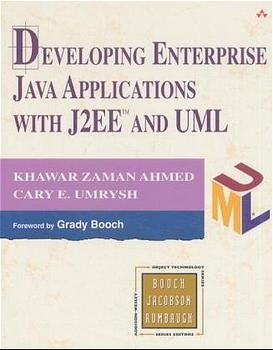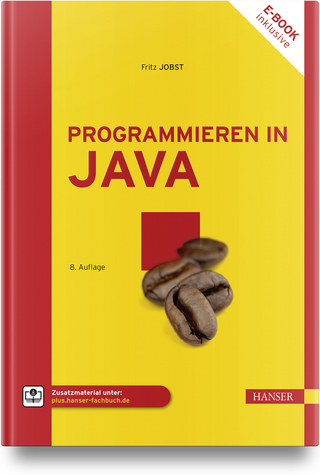
Developing Enterprise Java Applications with J2EE™ and UML
Addison Wesley (Verlag)
978-0-201-73829-2 (ISBN)
- Titel ist leider vergriffen;
keine Neuauflage - Artikel merken
The Java 2 Platform Enterprise Edition (J2EE TM) offers great promise for dramatically improving the way that enterprise applications are built, and organizations that have adopted the J2EE are gaining a competitive advantage. The industry-standard Unified Modeling Language (UML) has helped countless organizations achieve software success through visual modeling. Together, the UML and J2EE form a powerful set of tools, but the intricacies involved with using them in tandem are considerable.
While UML is highly effective for specifying, designing, constructing, visualizing, and documenting software systems, J2EE offers enterprise developers a simplified, component-based approach to application development. However, when using the two technologies together, developers must first consider--and attempt to reconcile--the different characteristics of each.
Developing Enterprise Java Applications with J2EE TM and UML examines the best ways to jointly leverage these technologies. Exploring concrete methods for completing a successful development project, the authors cover the use of UML and J2EE in detail. Using practical examples and a case study, they illustrate the pros and cons of specific design approaches, show how personal experience can affect design decisions, and demonstrate proven approaches for building better, software faster.
With this book as a guide, developers will be able to overcome the challenges in using UML and J2EE together, and be on their way to building robust, scalable, and complex applications.
0201738295B09042001
Khawar Ahmed is a member of the Rational Rose team at Rational Software Corporation. He assists internal and external customers of Rational Rose with the use of UML and Rational Rose in the areas of Java, J2EE, XML, and Web modeling. He has over eleven years of software development experience and has been using visual modeling since the early 1990s. Cary Umrysh has over twelve years of experience in object-oriented software development. Formerly a Rational Rose development manager and product manager at Rational Software Corporation, he is currently managing development teams for several key Enterprise Java software systems for use in the energy industry. 0201738295AB09042001
Foreword.
Preface.
Approach.
Intended Audience.
How to Use This Book.
Chapter Summaries.
Conventions.
Acknowledgements.
1. Introduction to Enterprise Software.
What is Enterprise Software?
Challenges in Developing Enterprise Software
Evolution of Enterprise Software
Enterprise Software and Component Based Software.
Summary.
2. Introduction to J2EE.
What is the Java 2 Platform, Enterprise Edition?
A Brief History of J2EE.
Why J2EE?
Brief Overview of J2EE.
Technologies.
API.
Other J2EE Technologies and API.
Summary.
3. Introduction to the UML.
What is the Unified Modeling Language (UML)?
Overview.
Why use the J2EE and the UML Together?
Challenges in Modeling J2EE in the UML.
Extension Mechanisms in the UML.
Stereotype.
Tagged Value.
Constraint.
The Approach to J2EE UML Modeling.
Summary.
4. UML and Java.
Introduction.
Representing Structure.
Class.
Variable.
Method.
Object.
Interface.
Package.
Representing Relationships.
Inheritance.
Realization.
Dependency.
Association.
Aggregation.
Composition.
Reflexive Relationships.
Summary.
5. Overview of Activities.
Introduction.
What is a Software Development Process?
Brief Overview of Popular Approaches to Software Development.
The Just-Develop-It Approach.
The Waterfall Process.
The Iterative Process.
The Rational Unified Process.
The ICONIX Process.
OPEN Process.
Extreme Programming/Feature-Driven Development.
Approach Used in This Book.
Overview of Major activities.
Chapter 6: Architecture.
Chapter 7: Analyzing the Customer Needs.
Chapter 8: Creating the Design.
Chapters 10-15 Detailed Design.
Chapters 16 Case Study.
Summary.
6. Architecture.
What is Software Architecture?
Why Architecture?
Key Concepts in Enterprise Application Architecture.
Decomposition.
Components.
Frameworks.
Patterns.
Layering.
Tiers.
Approaches to Software Architecture.
The J2EE View of Architecture.
The 4+1view Model of Architecture.
Hofmeister et al Four Views of Architecture.
Putting it All Together.
Summary.
7. Analyzing the Customer Needs.
Introduction.
Why software Analysis and Design?
Problem Analysis.
Use Case Modeling.
Actor.
Use Case.
Finding the Actors.
Finding the Use Cases.
Use Case Diagrams.
Use Case Relationships.
Include.
Extend.
Sequence Diagrams.
Activity Diagrams.
Summary.
8. Creating the Design.
Use Case Analysis.
Use Case Realizations.
Refined Use Case Description.
Sequence Diagrams.
Boundary Objects.
Entity Objects.
Control Objects.
Collaboration Diagrams.
Class Diagrams.
Coalescing the Analysis Classes.
Packaging.
Summary.
9. Overview of J2EE Technologies.
Overview.
The Big Picture.
Servlets.
JavaServer Pages.
Enterprise JavaBeans.
Session Beans.
Entity Beans.
Message-Driven Beans.
Assembly and Deployment.
Case Study.
Summary.
10. Servlets.
Overview.
Introduction to Servlets.
Common Usage.
Best Served Small.
J2EE Versions.
Servlet Lifecycle.
Lifecycle Methods.
Convenience Method.
Required Methods and Tagged Values.
Request Handling.
Response Generation.
HTTP Request Handlers.
Advanced Handler Methods.
Quick Guide to HTTP Requests.
The RequestDispatcher Interface.
Modeling Servlets in UML.
Modeling Other Servlet Aspects.
Servlet forward.
Servlet include.
ServletContext.
Servlet Session Management.
Servlet Deployment and Web Archives.
Identifying Servlets in Enterprise Applications.
Summary.
11. JavaServer Page.
Overview.
Introduction to JavaServer Pages.
Typical uses of JSP.
Model 1 and Model 2 architectures.
JSP versus Servlet.
Anatomy of a JSP.
Template data.
JSP Elements.
Objects Accessible to a JSP Implicitly.
Tag Libraries.
JSP and the UML.
Modeling Client Side Relationships.
Modeling Server Side Relationships.
JSP in Enterprise Applications.
Summary.
12. Session Beans.
Overview.
Introduction to Enterprise JavaBeans.
Enterprise JavaBean Views and the UML.
Basic Structure.
Representing an Enterprise JavaBean in UML.
Client View.
Internal View.
Session Beans.
Popular Beans
J2EE Versions.
Session Beans Types and Conversational State.
Modeling Session Bean Conversational State.
Instance Passivation.
Cleanup and Removal.
Transactions.
Transaction Demarcation.
Bean-Managed Transactions.
Container-Managed Transactions.
The SessionSynchronization Interface.
Limitations for stateless Session Beans.
Transaction Attributes.
Modeling Transactions.
Session Bean Technology.
Home Interface.
Remote Interface.
Implementation Class.
Modeling Interface Behavior.
Session Bean Lifecycle.
Session Bean Common Scenarios.
Modeling Session Bean Relationships.
Session beans and plain Java classes.
Session beans and JavaBeans.
Session beans and servlets.
Session bean and JSP.
Session-session relationships.
Session bean inheritance.
Identifying Session Beans in Enterprise Applications.
Summary.
13. Entity Beans.
Overview.
Introduction to Entity Beans.
Coarse-Grained Business Objects.
Increasing Popularity.
J2EE Versions.
Entity Bean Views and the UML.
Basic Structure.
Client View.
Internal View.
Persistence.
Transactions and Concurrency.
Abstract Persistence.
Abstract Persistence Schema.
EJB Query Language (EJB QL).
Persistence Manager.
Container-Managed Relationships.
Multiplicity.
Directionality.
Duplicating these Relationships in J2EE 1.2.
Local Relationships.
Entity Bean Technology.
Home Interface.
Remote Interface.
Primary Key Class.
Implementation Class.
Persistent Fields.
Entity Bean Lifecycle.
Entity Bean Common Scenarios.
Modeling Entity Bean Relationships.
Entity Bean and other Java classes.
Entity Bean and JavaBeans.
Entity Bean, Servlets and JSPs.
Entity Bean and Session Beans.
Entity Bean to Entity Bean relationships.
Identifying Entity Beans in Enterprise Applications.
Layering.
Summary.
14. Message-Driven Beans.
Overview.
Introduction to Message Beans.
The Java Message Service.
Role of JMS and Message Beans in EJB.
Why use Messaging and Message Beans.
When to use Message Beans.
J2EE Version.
Message Bean Views and the UML.
Basic Structure.
Client View.
UML Benefits for Message Beans.
Modeling Messages.
Modeling Destinations.
Message Bean Technology.
Transactions.
Implementation Class.
Message Bean Lifecycle.
Message Bean Common Scenario.
Modeling Message Bean Relationships.
Modeling relationships with other classes.
Message Bean and other J2EE technologies.
Identifying Message Beans in Enterprise Applications.
Summary.
15. Assembly and Deployment.
Introduction.
Component Modeling.
Component modeling of J2EE technologies.
Representing Web Components.
Representing Enterprise JavaBeans.
Component modeling of enterprise applications.
Deployment Modeling.
Traceability revisited.
Assembly and deployment of Enterprise Java Applications.
Deployment Descriptors
Summary.
16. Case Study.
Introduction.
Case Study Background.
Problem Statement.
Rationale and Assumptions.
HomeDirect Requirements.
Inquiry Services.
Bill Payment Services.
Transaction Services.
Administrative Services.
Inception Phase.
Initial Iteration.
Elaboration Phase.
Elaboration Iteration#1.
Elaboration Iteration#2.
Elaboration Iteration#3.
Remaining Phases.
Summary.
Appendixes.
Index. 0201738295T07122001
| Erscheint lt. Verlag | 30.10.2001 |
|---|---|
| Verlagsort | Boston |
| Sprache | englisch |
| Maße | 234 x 186 mm |
| Gewicht | 640 g |
| Themenwelt | Mathematik / Informatik ► Informatik ► Netzwerke |
| Informatik ► Programmiersprachen / -werkzeuge ► Java | |
| Mathematik / Informatik ► Informatik ► Web / Internet | |
| ISBN-10 | 0-201-73829-5 / 0201738295 |
| ISBN-13 | 978-0-201-73829-2 / 9780201738292 |
| Zustand | Neuware |
| Informationen gemäß Produktsicherheitsverordnung (GPSR) | |
| Haben Sie eine Frage zum Produkt? |
aus dem Bereich


